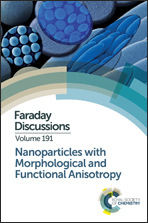Wetting and orientation of catalytic Janus colloids at the surface of water
Abstract
Janus colloidal particles show remarkable properties in terms of surface activity, self-assembly and wetting. Moreover they can perform autonomous motion if they can chemically react with the liquid in which they are immersed. In order to understand the self-propelled motion of catalytic Janus colloids at the air–water interface, wetting and the orientation of the catalytic surface are important properties to be investigated. Wetting plays a central role in active motion since it determines the contact between the fuel and the catalytic surface as well as the efficiency of the transduction of the chemical reaction into motion. Active motion is not expected to occur either when the catalytic face is completely out of the aqueous phase or when the Janus boundaries are parallel to the interfacial plane. The design of a Janus colloid possessing two hydrophilic faces is required to allow the catalytic face to react with the fuel (e.g. H2O2 for platinum) in water and to permit some rotational freedom of the Janus colloid in order to generate propulsion parallel to the interfacial plane. Here, we discuss some theoretical aspects that should be accounted for when studying Janus colloids at the surface of water. The free energy of ideal Janus colloidal particles at the interface is modeled as a function of the immersion depth and the particle orientation. Analytical expressions of the energy profiles are established. Energetic aspects are then discussed in relation to the particle’s ability to rotate at the interface. By introducing contact angle hysteresis we describe how the effects of contact line pinning modifies the scenario described in the ideal case. Experimental observations of the contact angle hysteresis of Janus colloids at the interface reveal the effect of pinning; and orientations of silica particles half covered with a platinum layer at the interface do not comply with the ideal scenarios. Experimental observations suggest that Janus colloids at the fluid interface behave as a kinetically driven system, where the contact line motion over the defects decorating the Janus faces rules the orientation and rotational diffusion of the particle.
- This article is part of the themed collection: Nanoparticles with Morphological and Functional Anisotropy

 Please wait while we load your content...
Please wait while we load your content...